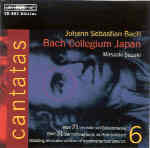Volume 6 in Masaaki Suzuki’s Bach cantata cycle features only two works–however, given how frequently they were performed and how often they were revised by the composer for different venues and personnel, these cantatas must have been highly esteemed by Bach. By this time (1714/15) Bach had hit his stride at Weimar, continuing to experiment with instrumentation and cantata form, drawing collaborative inspiration from librettist Salomo Franck and, most importantly, furthering his status and reputation on his way to an eventual post in Leipzig.
Cantata Ich hatte viel Bekümmernis BWV 21 certainly is one of Bach’s grandest, an 11-movement, two-part masterpiece far longer (and longer still if programmed with the alternative movements Suzuki offers as an option) and broader in scope than any to date. The work begins with a dramatically slow sinfonia in D minor, a stately march of oboe, bassoon, and violin gradually augmented with strings and an organ continuo that combine to impress the listener with the cantata’s scale and stature. Throughout Part 1, tenor Gerd Türk and soprano Monika Frimmer wrestle with their doubts, applying plenty of charisma and expressive virtuosity to their search for and ultimate discovery of spiritual consolation (Frimmer’s frequent runs and sustained breath control in the taxing fifth-movement aria–incorrectly marked “tenor” in the booklet–is often astounding).
In Part 2 Bach returns to a dialogue first heard in the final duet of Cantata BWV 152 (Vol. 5) where Jesus and the Soul corroborate their mission. Now all becomes lighter, the exchanges between Frimmer and Türk, who no longer are mortal subjects, often approach Italian opera buffa, and a final rousing triumphant chorus studded with trumpets and timpani provides a perfect conclusion to this ambitious undertaking. Until now BWV 21 has received many fine recorded performances (Rilling, Richter, Harnoncourt, and to a lesser extent Koopman) though Suzuki provides us with our first truly great one.
This is not the case however with BWV 31, where Fritz Werner’s benchmark 1964 Erato recording has provided much pleasure over the years. While Suzuki’s performance certainly is stirring (and in most instances his tempos are faster), he fails to elicit as much urgency and sense of spontaneous rapture, particularly with the chorus and brass, that makes Werner’s rendering so memorable and thrilling. Also, while Türk and Kooy more than adequately match their Erato competitors–bass Erich Wenk and tenor Helmut Krebs–Frimmer never equals soprano Agnes Giebel’s uncanny versatility of range, flights of expression, and subtle timbre. After Werner (which incidentally is long-deleted on CD), Suzuki’s performance rates with the very best; and strictly in terms of sonic clarity, it is the finest-sounding recording currently available.
































